
Outlets in kitchens and bathrooms — Plug into the details
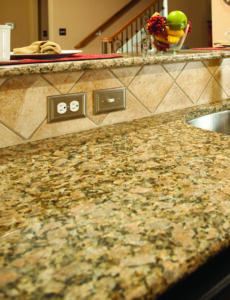 The National Electrical Code (NEC) requires outlets in kitchens. This article discusses accessibility to outlets over a counter. The NEC says every piece of counter 12 inches or wider must have an outlet over it. In addition, there must be at least one outlet every 4 feet. When you have an L-shaped piece of counter, that effectively puts at least one outlet in the back corner. The ICC A117.1 requires a clear floor space of 30 inches by 48 inches in front of a counter so a person in a wheelchair can reach the outlets. This in itself sounds fairly simple, but the details can spark confusion.
The National Electrical Code (NEC) requires outlets in kitchens. This article discusses accessibility to outlets over a counter. The NEC says every piece of counter 12 inches or wider must have an outlet over it. In addition, there must be at least one outlet every 4 feet. When you have an L-shaped piece of counter, that effectively puts at least one outlet in the back corner. The ICC A117.1 requires a clear floor space of 30 inches by 48 inches in front of a counter so a person in a wheelchair can reach the outlets. This in itself sounds fairly simple, but the details can spark confusion.
Outlets in commercial kitchens are exempted as elements of employee workstations (International Building Code Section 1103.2.2). Therefore, this discussion concerns kitchens within Accessible, Type A and Type B dwelling units, and accessible kitchens outside a dwelling, such as kitchens within a clubhouse or community room.
There are three things to consider: (1) placement of the clear floor space in relation to the outlets; (2) reach depth; and (3) the height of obstructions.
Possible placement of the clear floor space
A stock kitchen cabinet is typically 36 inches high and 24 inches deep, with a 1.5-inch lip overhang for the countertop. A standard range is 25 1/2 inches to 29 inches deep and 36 inches high. A standard refrigerator is 28 inches to 33 inches deep. Therefore, the range and refrigerator are going to stick out farther than the counter. Where there is less than a 48-inch stretch of countertop on either side of the refrigerator or oven, it is impossible to get the clear floor space immediately adjacent and parallel to the face of the cabinets. For the range, there is the option of a countertop cooktop and wall oven to keep the depth at 24 inches. But these appliances are typically a greater cost than a standard range.
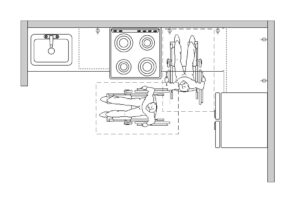
For the refrigerator, you could build a recess, but there are a couple of issues: 1) the extra construction cost of building an alcove instead of a straight wall; 2) possible loss of circulation/functionality on the other side of that wall; and 3) the doors have to be out past the front edge of the counter enough to allow the doors to swing open or the space has to be made wider to accommodate the door swing. There also is the option of a “counter depth” refrigerator, but again, this costs more than a regular refrigerator and has the same issues with the doors opening. It is not practical to require a clear floor space flush with the cabinet face for every outlet. The clear floor space will be offset by the appliances.
Reach depth for kitchen and bathroom outlets
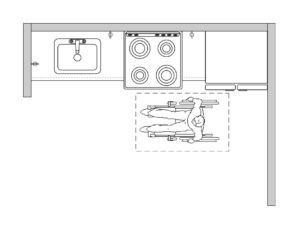
Even if you have a 48-inch stretch of countertop, the standard 1.5-inch lip of the counter provides a 25.5-inch depth of reach. The obstructed side reach in ICC A117.1 Section 308.3.2 shows an obstruction with a maximum depth of 24 inches. From a usability point of view, the cabinet below is the obstruction to the wheelchair, not the countertop. Pulls on the cabinets or drawers are not considered an obstruction, so it seems logical and consistent to allow the same protrusion for the counter lip. I have seen the idea of surface mounting outlets forward a couple of inches. While that addressed the depth, it still does not solve the height issue; our next point for discussion.
Height of an obstruction for kitchen and bathroom outlets
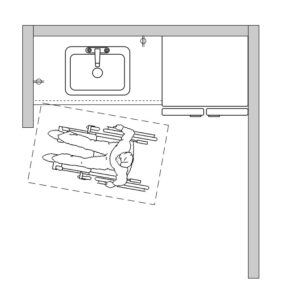
In a fully accessible kitchen, the work surface and sink have a maximum height of 34 inches. Outlets above the accessible workspace, where knee and toe space are provided, will be within reach. Nothing in the kitchen requirements say the remainder of the kitchen counter has to be set at 34 inches. However, ICC A117.1 Section 308.3.2 shows reach over an obstruction with a maximum height of 34 inches. If a designer places the outlets on the back wall over the cabinets, the obstructed reach would appear to force the entire counter to a height of 34 inches maximum to allow reach for the outlets. There are issues with using the lower cabinet height throughout the kitchen: Standard ranges and dishwashers are built assuming a 36-inch high counter height. Standard stock cabinets are constructed for a 36-inch height. There are 34-inch stock cabinets available, but those are typically made for bathrooms, so storage features and options would be limited.
What are the options if a standard 36-inch cabinet is used? The obstructed reach allows for a reach depth of less than 10 inches over a higher counter — so there is the option of putting the outlet on side walls instead of the back wall, or reaching the outlet from the end of the cabinet instead of the front. There is the option of outlets on the front or side of the cabinets; or the pop-up/tombstone outlets. The outlets on the front of the cabinets typically would require the removal of some drawers, which is possibly the most accessible storage areas in the kitchen. However, the outlet on the side of the cabinets is an option often used on kitchen islands. The cords hanging over the front of the counter would be a safety hazard for someone moving around in the kitchen and possibly snagging the cord with their wheelchair, as well as a hazard for any small children who might be in the kitchen. Pop-up/tombstone outlets are expensive, and the depth required also would result in losing a number of the drawers in the kitchen.

anmi3PLIG59uDZVV6WpEIMVAdZj818Pp_Bxwxbg4obU=.html
Putting outlets on the underside and front edge of the upper cabinets seems like a good solution for depth, but there is still the reach height. If you lower the upper cabinets to get the outlets to a height of less than 48 inches the counter space under the upper cabinets is not high enough for many countertop appliances such as coffee makers, blenders or stand mixers. The 2009 ICC A117.1 removed the requirement for the upper cabinets to be within reach range in accessible unit kitchens due to this concern.
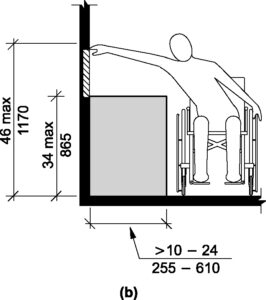
Personally, I believe the building block provisions for reach were designed for accessible work surfaces. The impact on kitchen design combined with NEC outlet requirements was not evaluated to the level of detail currently being scrutinized.
There is the exception for a second outlet in a stretch of countertop (ICC A117.1 Exception 2 of Sections 1002.9, 1003.9 and 1004.9), but that typically exempts only the back corner outlet over an L shape since it still requires one accessible outlet. There is an exception for dedicated outlets (ICC A117.1 Exception 1 of Sections 1002.9, 1003.9 and 1004.9), but that typically covers only outlets for major appliances or an outlet within an appliance barn. Outlets in accessible kitchens outside a dwelling are not addressed in ICC A117.1 requirements for operable parts or kitchens (ICC A117.1 Sections 309 and 804); however, a designer can use the exceptions for dedicated outlets and duplicative outlets in the IBC (IBC Section 1109.13, Exceptions 2 and 3). The intent for the scoping is such that kitchens are the same as within a unit addressed in ICC A117.1 Chapter 10.
The 2009 ICC A117.1 provided an exception within Type B units for switches and electrical outlets over cabinets that are the standard 36-inch height with a 25.5-inch depth countertop (ICC A117.1 1004.9, Exception 10). This is consistent with the Fair Housing Design Guidelines. While this does not address the clear floor space placement question, it does at least take away the depth and height concerns for Type B units. For best design practice, when looking at outlet placement, it must be considered that the true reach for side approach is really only the center 2 feet of the 4-foot length.
It was proposed to the ICC A117.1 development committee that the 36-inch high cabinets with 25.5-inch deep counters were appropriate in all kitchens when looking at reaching for outlets. The committee chose to wait for a wheeled mobility study in progress at the time to have technical data to back up any allowance within Accessible and Type A dwelling units and accessible kitchens.
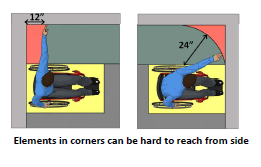
Unfortunately, while this study is now complete, “reach over an obstruction” was not included so there is no technical data to provide to the A117.1 committee to revise this requirement.
In my opinion, appliances sticking out further than the base cabinets, cabinet pulls and the standard countertop edges are not “obstructions” for reaching outlets. For the best design, the outlets should be located to meet NEC requirements and for the best possible access for reach, such as on a side wall or located to consider the true reach illustrated earlier in this article. Providing additional outlets in more accessible locations could be a viable alternative to attempting to provide full access over every piece of countertop. Any alternatives (ICC A117.1 Section 103) must be approved by the authority having jurisdiction. For example, recently I saw a product that put a series of outlets inside a drawer. While this most likely was designed for people to charge phones and tablets off the counter, it did place outlets in an accessible location.

anmi3PLIG59uDZVV6WpEIMVAdZj818Pp_Bxwxbg4obU=.html






